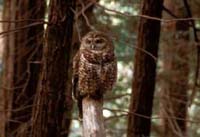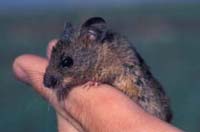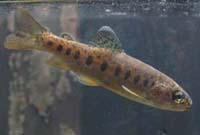
Northern Spotted Owl
The natural communities of the watershed reflect the variety of local soil types, drainage patterns, elevations, slope, and orientations to sun and wind. The following natural communities are found in the watershed: Northern Coastal Scrub, Chaparral, Grasslands, Coastal Salt Marsh, Freshwater Marsh, Vernal Marsh (Seasonal Wetland), Coastal Riparian Forest, Valley Oak Woodland and Oak Savannah, Coast Live Oak Woodland, and Mixed Evergreen Forest. A number of rare plant species are found in or adjacent to our watershed, especially where serpentine is exposed. There is substantial urban and suburban development within the watershed, so habitats in the watershed also include suburban gardens, urban parks and roadsides.
Our watershed provides habitat to species that have adapted well to urban and suburban development, including mule deer, raccoon, opossum, skunks, numerous birds, and a variety of reptiles and amphibians. Mountain lions, coyotes and river otters are occasional visitors. The federally endangered California clapper rail and salt marsh harvest mouse and the threatened northern spotted owl occur in the watershed.

Salt Harvest Mouse
Over the years, sightings of adult steelhead (Oncorhynchus mykiss), coho salmon (O. kisutch) and Chinook salmon (O. tshawytscha) have been reported for the Corte Madera Creek watershed. These fish migrate from the ocean to spawn in the shallow headwater streams where they hatched, although pairs of Chinook salmon seen in 2001and 2003 were probably strays from the Sacramento River. Coho salmon sightings in winter were quite common up to the 1970s, when degradation of its habitat ended spawning runs; in some years during the 1950s spawning fish were so plentiful on the Drake High School campus that students could gather them up. Unlike coho and Chinook salmon, steelhead survive spawning, returning immediately to the ocean, so are not often seen as adults. However summer surveys of pools continue to record them in fair numbers, especially in upper San Anselmo and Cascade creeks in Fairfax. Among the many consequences of urbanization that have diminished the steelhead run, the construction of the mile-long concrete channel in Ross and Kentfield was the most dramatic: in 1971, immediately after the channel’s completion, steelhead was still the dominant species by number in Ross, while surveys conducted in 1973-1975 showed that it had been relegated to a minor species. Steelhead is classified as a threatened species under the federal Endangered Species Act, and this status provides leverage for improving creek habitat in our watershed, to the benefit of all species.(Some members of the species O. mykiss, the same species as steelhead, spend their entire lives in freshwater, in which case they are called rainbow trout. It is possible that some of the adult fish found in Corte Madera Creek watershed are rainbow trout.)

Juvenile Rainbow Trout
For more information:
Fish&Wildlife.pdf (204 KB)
FisheriesES.pdf (52KB)
FloraAndFloraOfUplandCMCW.pdf
FloraAndFloraOfUplandAndLowlandCMCTidalSaltMarshes.pdf
NatCommPlants.pdf (290 KB)
PlantIDInvasivePlants.pdf (332 KB)
PlantID Native Shrubs and Vines.pdf (317 KB)
PlantID Native Trees.pdf (52KB)
San Anselmo Creeks Survey (pdf)
